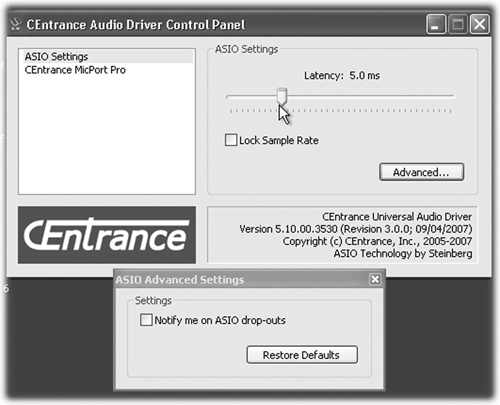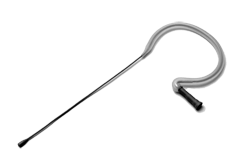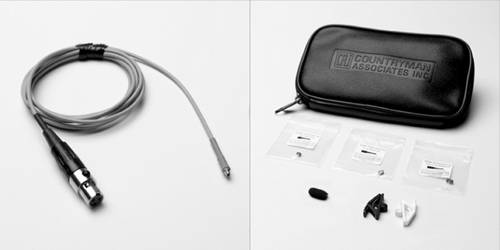
NO NOIZE
It was while I was actually recording that I noticed the MicPort Pro’s lack of self-noise. I zoomed in on the vertical axis to see if I could see any hint of extraneous noise during silence — I could not. It was at that point that I began to realize that CEntrance probably put a great deal more effort into the circuit design of the MicPort Pro then others have. Here in the office we have three USB headset mics that we bought for use with Skype. These definitely fall into the category of consumer products, and their microphones generate a fair amount of self-noise. So I decided to do a little investigation to see what the difference was between the MicPort Pro and these consumer products.
As one might expect, most manufacturers of USB headset mics don’t design them for professional audio use. They’re designed for voice over IP, so most of them work only at 16 bits, and have poor noise specs. On the other hand, these chipsets are inexpensive (some less than a dollar a piece in quantity) and they get the basic job done. You might not be surprised to learn that musical instrument manufacturers use some of these same chipsets, and their specs show it.
About a year ago SoundTech, a musical instrument company, introduced their LightSnake audio-to-USB microphone and guitar cables, which they describe as a USB interface in a cable (actually the USB interface portion is molded into the cable at the audio end). In this case what seems a great idea is marred by a consumer-grade 16-bit analog to digital (A/D) converter, resulting in an unacceptably high noise floor. Good enough for Skype, but certainly not for a pro microphone.
CEntrance has clearly gone the extra mile in designing the MicPort Pro. I went so far as to ask their public relations representative if they were willing to “open the kimono” a bit and tell me what they are doing. I understood when they declined, but they did provide me with the following quote: “After eight years of working as a leading design consultancy for the top names in the Pro Audio industry, CEntrance knows high tech. The MicPort Pro might be small and deceptively simple on the outside. But the circuitry inside represents years of experience in hardware, custom firmware, driver and packaging design that culminated in the quality and reliability of this professional-level solution.”
Allow me to translate... no, they’re not going to tell me how they do it. And since the unit that’s here in my hand still belongs to them, and since I suspect things are rather tightly packed inside, I’m reluctant to disassemble it (oh I will alright, but only after I’ve paid for it). But a little digging on the company’s website tells me that they’ve been writing USB and Firewire audio drivers for other companies for a while now, and I’m willing to bet they’ve got some first-rate hardware talent on board as well. I can’t disagree with the quote. The MicPort Pro sounds clean and quiet, particularly with a vintage Neumann or Telefunken recording at 96/24.
It’s a keeper. The MicPort Pro carries a suggested retail price of $149.95, and is available now. For more information worldwide, visit www.CEntrance.com.
 COUNTRYMAN E6 EARSET MICROPHONE
COUNTRYMAN E6 EARSET MICROPHONE
The Countryman E6 is the smallest pro-level microphone I know of. It’s an electret condenser that’s available in both omnidirectional and cardioid patterns, but my experience with it tells me that omnidirectional is a better choice due to its complete lack of a proximity effect. This is not a big-voice VO microphone. Instead, it is a very natural-sounding microphone that provides the kind of clarity and punch that makes it perfect for broadcast use, particularly for podcasting.
You can bend the boom in the earpiece to make it fit perfectly on you, even if you wear glasses as I do, and the whole business weighs less than a tenth of an ounce. I often forget that I’m wearing it. Its frequency response is extremely flat, with a very slight rise around 15 kHz. It has low self-noise, and can withstand levels up to 140 dB (in case you’re a screamer).

Best of all, the audio cable plugs into the earpiece. Should you happen to roll your chair over the cable and break it (or forget you’re wearing it and get up quickly), you can replace just the cable without having to replace the boom or earpiece. It works on any phantom power source from 3 V up to 48 V, so it’s an ideal companion for the MicPort Pro, as well as other interfaces. And it comes with a nice little vinyl carry pouch, which has enough extra space for the MicPort Pro.
However, all this goodness comes at something of a price — the E6i retails for $514.60 in the US. Street prices are slightly lower, but this is not a cheap microphone. It’s a very specialized, professional microphone that does its job very well for those of us who have to travel and talk as well. There’s not a lot else to say about it — it’s very small, it sounds good, and it’s road-worthy. So you’ll excuse me — I gotta go pack a bag.
For more information worldwide on the Countryman E6i, visit www.countryman.com.
♦
